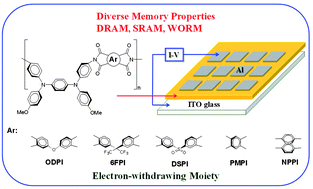Resistive switching non-volatile and volatile memory behavior of aromatic polyimides with various electron-withdrawing moieties†
Abstract
In this study, N,N′-bis(4-aminophenyl)-N,N′-di(4-methoxyl-phenyl)1,4-phenylenediamine [(OMe)2TPPA-diamine] and various dianhydrides such as oxydiphthalic dianhydride (ODPA), 3,3′,4,4′-diphenylsulfonetetracarboxylic dianhydride (DSDA), pyromellitic dianhydride (PMDA), and 1,4,5,8-naphthalenetetracarboxylic dianhydride (NPDA) were used to synthesize new functional polyimides (OMe)2TPPA-ODPI (ODPI), (OMe)2TPPA-DSPI (DSPI), (OMe)2TPPA-PMPI (PMPI), and (OMe)2TPPA-NPPI (NPPI), respectively for memory device applications. For comparison, the corresponding (OMe)2TPPA-6FPI (6FPI) was also added into the discussion. The differences of HOMO energy levels, LUMOs energy levels, and dipole moment among these five polyimides with different electron-withdrawing linkage were investigated and demonstrated the effect on the memory behavior. With the electron-withdrawing moiety intensity of polyimides increasing, the retention time of corresponding memory device increases. ODPI didn't have memory properties, 6FPI exhibited DRAM characteristic, and PMPI with stronger electron-withdrawing linkage revealed SRAM behavior. NPPI with the strongest electron-withdrawing linkage showed WORM type non-volatile memory behavior. Interestingly, DSPI have the LUMO energy levels between 6FPI and PMPI but revealed non-volatile WORM behavior resulting from the highest dipole moment 5.45 D.


 Please wait while we load your content...
Please wait while we load your content...